By: Kimber Dunn
Raising Children to be Safe Around Firearms.
There are few more gratifying events in life than watching your children learn, grow, and excel at a new skill. Introducing your child to safely shooting is no different. Hunting, personal protection, home defense, and competitive shooting has to start somewhere. Here are a few personal recommendations from a hunter and competitive shooter that is currently raising two children around guns.
Let me start by saying your children’s safety is your responsibility. I will give recommendations based on the maturity level of my children and my personal life experiences. If you are unsure about any aspect of having guns around your children, please contact a reputable firearms instructor directly.
 Safety:
Safety:
Safety begins before the shooting does. There are 4 firearm safety rules commonly recognized across all shooting disciplines, the wording may differ slightly, but the general idea is the same:
1. All guns are always loaded and should be treated accordingly.
2. Never let the muzzle cover (point your gun at) anything you are not willing to destroy.
3. Keep your finger off the trigger until your sights are on the target and you have made the decision to fire.
4. Identify your target, and what is behind it.
You must know these rules and be able to portray their meaning in a way that your child will understand. You also must be in a position to immediately correct and physically enforce these rules until your child has been able to repeatedly show their understanding and safety.
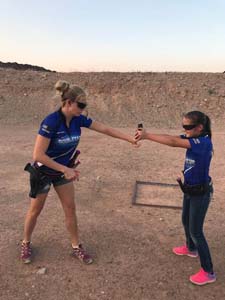 The NRA has many great resources and videos for parents and children to prepare for their first shooting experiences. Visit explore.nra.org/interests/youth-interests and eddieeagle.com for more information.
The NRA has many great resources and videos for parents and children to prepare for their first shooting experiences. Visit explore.nra.org/interests/youth-interests and eddieeagle.com for more information.
Children should be taught from a young age that if they find an unattended gun they should: Stop, don’t touch it, leave the area, and tell a parent or adult.
All shooting should take place using proper eye and ear protection. This should be a given. But I have witnessed events where blindness in a child is a possibility and hearing damage is imminent.
 Young Children:
Young Children:
Your decision on what age to allow a child to shoot their first gun is dependent upon many variables. Their maturity, size, strength, the shooting location, type of firearm, and caliber of firearm must all be considered.
Maturity is usually the largest factor and should be heavily considered. Only you can know if your child is ready. I’ve seen some parents allow their 3-year-old to shoot a single shot .22 LR from prone position at a secluded range. There is not a magical age to begin this process. But, for the sake of averages let’s consider this group of children to be early elementary school age.
Here are a few recommendations I found beneficial while preparing my two daughters for their first gun shooting experience.
1. Minimal Recoil: Any of the .17 or .22 caliber rimfire cartridges (.22 short, .22 LR, .22 Magnum, .17 HMR, etc.) are a good option. These are cheap, low recoil, fairly accurate, and relatively quiet.
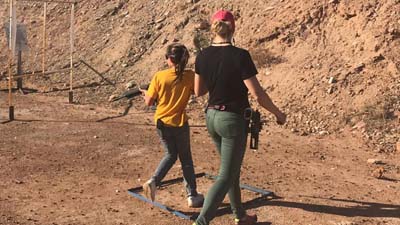 2. Single-Shot or Bolt-Action Rifle: This helps teach them to make the shot count and is easier to control their rate of fire. It doesn’t matter if you are starting with a budget Crickett single-shot or premium Vudoo Gun Works bolt-action, your child will have a blast! Prone position or shooting from a bench rest is a great way to keep the gun pointed in a safe direction and give them the confidence of making good hits. Handguns can be a little more problematic to keep pointed down range. Sometimes children want to get your attention or make sure you saw them shoot and can turn around with the gun pointed in an unsafe direction, like your face.
2. Single-Shot or Bolt-Action Rifle: This helps teach them to make the shot count and is easier to control their rate of fire. It doesn’t matter if you are starting with a budget Crickett single-shot or premium Vudoo Gun Works bolt-action, your child will have a blast! Prone position or shooting from a bench rest is a great way to keep the gun pointed in a safe direction and give them the confidence of making good hits. Handguns can be a little more problematic to keep pointed down range. Sometimes children want to get your attention or make sure you saw them shoot and can turn around with the gun pointed in an unsafe direction, like your face.
3. Reactive Targets: Various sized steel targets at different distance can give confidence while also giving a gratifying “ding” when hit. Various fruits and vegetables such as; potatoes, pumpkins, melons, and apples. If you use hollow points this can be gratifying to watch the results. It also gives the child an idea of how powerful and dangerous even a small cartridge can be. Unopened soda cans can be fun too, but make sure you clean up your mess afterwards!
4. Optics: While I believe it is important for everyone to be able to shoot iron sights, it is easier to shoot optics. The most simple and easiest to shoot is a red dot sight. Sportsman’s Warehouse offers a variety of optics I’d recommend to fit any budget from Holosun to Eotech and Aimpoint. There is no lining up front and rear sights like iron sights. There is no eye relief like a scope. You could, and should, shoot two eyes open. Make sure you sight in the optic at the distance your child will be shooting at so there is less for your child to worry about like mechanical offset (difference between the height of your bore and dot). If done correctly you can tell your child to look through the glass, put the dot where you want the bullet to go, and squeeze the trigger.
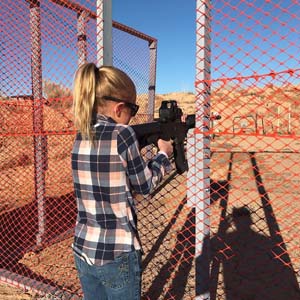 The Next Step:
The Next Step:
Once your child becomes comfortable and safe on the above shooting you may be ready for the next level. The next level may look differently depending on your end goal. If your end goal is a proficient rifle hunter or long-range shooter you may want to increase caliber size and distances as your child grows. If the desire is a bird hunter you can start with a .410 shotgun and work your way larger. Start with breaking targets on the ground then graduate to hitting clay pigeons in the air.
My experience lies in competitive pistol and multi-gun shooting. This type of shooting requires much more time spent on dry fire training. Dry fire training is where there is no ammunition in the guns, magazines, or readily accessible. This is a great way to verify how your child’s safety and training is coming along with less risk of loaded guns. It is vital for safety that the muzzle of the gun points up-range and never crosses any part of the competitor’s body. You should also heavily train to make sure the finger never touches the trigger or trigger guard unless actively engaging a target. The finger must be indexed on the slide or frame of the gun while moving, reloading, or any other manipulation of the gun.
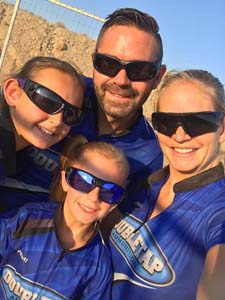 Jalise and Justine Williams, both previous authors for Sportsman’s News Trigger Time articles, are both shining stars for how children should be introduced to competitive shooting. These girls started shooting Tuesday Night Steel at the Southern Utah Practical Shooting Range in St. George, Utah years ago at the ages of 7 and 9 years old, if I remember correctly. These girls were shooting .22 handguns then moved to .380 ACP then 9mm. Now they shoot everything under the sun including virtually every Division in USPSA and the Robinson Armament XCR in multi-gun. Both parents were also at the range with them and made sure they were spot-on for safety and very strict on any sort of horseplay. They were exactly what those girls needed to be set up for success. The girls then earned every win by hard-work training at the range and doing dry fire at home. Now both girls have won almost every Division at the USPSA National Championships in 2019. If you haven’t read their articles you should definitely find and read them.
Jalise and Justine Williams, both previous authors for Sportsman’s News Trigger Time articles, are both shining stars for how children should be introduced to competitive shooting. These girls started shooting Tuesday Night Steel at the Southern Utah Practical Shooting Range in St. George, Utah years ago at the ages of 7 and 9 years old, if I remember correctly. These girls were shooting .22 handguns then moved to .380 ACP then 9mm. Now they shoot everything under the sun including virtually every Division in USPSA and the Robinson Armament XCR in multi-gun. Both parents were also at the range with them and made sure they were spot-on for safety and very strict on any sort of horseplay. They were exactly what those girls needed to be set up for success. The girls then earned every win by hard-work training at the range and doing dry fire at home. Now both girls have won almost every Division at the USPSA National Championships in 2019. If you haven’t read their articles you should definitely find and read them.
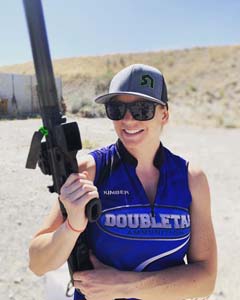 The NRA and USPSA have great resources to help find nearby ranges and get you prepared to take your child for their first of many great shooting experiences.
The NRA and USPSA have great resources to help find nearby ranges and get you prepared to take your child for their first of many great shooting experiences.
About the Author:
Kimber Dunn is the mother of an 11-year-old daughter and 9-year-old daughter. Kimber has been shooting competitively since 2013. She has won numerous High Lady honors in the Utah and Colorado Handgun Championships. She is currently a sponsored shooter for Doubletap Ammunition, 8 Eyewear, Breakthrough Clean, RMR Rubicon, Powder Valley, Inforce Lights, and Taran Tactical Innovations. Follow her on Instagram to see her and her daughters progress in the shooting sports, @dunn.kimber

